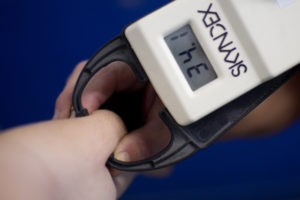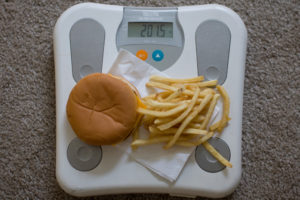Facing Down the Issue of Childhood Obesity

Body fat percentage, measured using skin calipers like these, is one way to measure obesity, defined as over 25% for men or 32% for women. Photo by Tara Haelle
By Megan Jones
Diabetes, heart disease, high blood pressure, high cholesterol and sleep apnea. Those are adult problems, right? Not anymore.
One out of three children in the United States is overweight or obese and thus at risk for these and other health concerns. Adolescent obesity is running at 18.1 percent nationwide, and 14 percent of Texas high school students – one in seven – are obese, according to the federal Centers for Disease Control and Prevention.
Joel Harrison, 30, a freelance photographer in Austin, was one of those overweight kids, and he had a hard time growing up as a result. “I was fat all my life from the age of 4 to the age of 22,” he said. “I received a lot of scorn from my classmates, friends and family members. I had a lot of family members who picked on me relentlessly.”
The U.S. government has recognized the epidemic. First lady Michelle Obama started a program in May 2010 called Let’s Move to battle childhood obesity. The USDA is considering barring the sale of sugary drinks and high-calorie snacks in vending machines in schools. Congress extended the Child Nutrition Act through the end of 2010 and President Barack Obama proposed spending $10 billion over 10 years so public schools have more money to serve healthier foods.
The biggest factor is that young Americans grow up in a society where, in general, “we’re taking in too many calories and taking too few calories off,” according to Stephen Pont, medical director for the Texas Center for the Prevention and Treatment of Childhood Obesity. “Pretty much every improvement we’ve made as a society [to make life easier] has directly or indirectly contributed to this epidemic. Now we all drive and walk less. We have computers and more sedentary jobs.”
Eating more and exercising less are obvious contributors to childhood obesity, but some factors are much less plain. Farm subsidies have made corn and corn products such as high-fructose corn syrup cheaper, which means, Pont said, that less-healthy food is more easily available. CDC data indicate that U.S. men are eating 2,638 calories a day, up from 2,450 in 1971, and women are eating 1,785 a day, up from 1,542, eight and and 14 percent, respectively. The USDA, which uses different methods, says the increases have been even larger, up to 600 calories a day since 1971, or 24 percent. Calories from corn products like corn flour, corn meal hominy and corn starch have increased 191 percent since 1970.
Sugar intake overall has risen 14 percent since 1970, from 401 calories a day to 459, but calories from corn sweeteners such as high-fructose corn syrup are up 359 percent. This means that, on average, American are taking in 246 extra calories a day from corn sweeteners alone, according to a study on agricultural policy and childhood obesity by David Wallinga, director of the Food and Health Program at the Institute for Agriculture and Trade Policy in Minneapolis.
Farmers grow the crops that agricultural policy encourages, according to Wallinga’s study. The government subsidizes production of commodities — like corn, wheat, cotton, rice, milk and soybeans — that are easy to produce on a large scale and easy to ship and store. It used to be that research suggested that giving children food high in fat and sugar helped them grow; the USDA’s first food guide, in 1916, listed five food groups, two of which were fatty foods and sugary foods. Large-scale production of those commodities was seen as a sign of prosperity, and those foods were considered good nutrition.
The government responded by pushing the production of sugar crops, and farmers began to grow more than ever. Today the major nutrition-related health problem in the United States is obesity, not undernourishment, but that’s the problem the system is still set up to combat, according to Wallinga’s study. Meanwhile, farmers receive no subsidies for producing fruits and vegetables.
While commodity farming contributes to the childhood obesity epidemic, it is not entirely to blame. The nature of many food businesses allows producers and retailers to increase their profit margin by selling larger portions, Pont said.
For example, a soft-drink company that makes a profit by producing a certain amount of sugary drink can produce and sell more using the same equipment for just a small cost of additional ingredients; the more it makes and sells, the greater its average profit. And when, say, McDonald’s offers a promotion of any size drink for $1, it increases store traffic and sales while moving more large sodas out the drive-through window.
Advertising also encourages the obesity epidemic. According to media analyst A.C. Nielsen, the average American household has 2.4 televisions, and at least one TV is on an average of four hours a day—but children watch about twice as much TV as adults and see a lot of ads for sweets and fatty foods. “There is a lot of advertising to convince children to get their parents to buy unhealthy food and products. The food tastes good, so kids continue to ask for it,” Pont said. “Kids are getting hammered with ads while they watch TV.”

- Fast food is just one of various factors contributing to the childhood obesity epidemic. Photo by Tara Haelle
Health professionals use body mass index, a measurement of weight in relation to height, to indicate whether someone is overweight or obese. Young people ages 2–19 in the top 15 percent of body mass indexes are considered overweight, and those in the top 5 percent are considered obese, according to the CDC. The normal body mass index varies considerably based on sex and age, but as an example, the average 14-year-old boy is just over 5 feet tall and weighs about 110 pounds, with a healthy BMI of 20.8. At 130 pounds, with at BMI of 24.6, he would be considered overweight.
Obese children and adolescents experience a range of side effects from their weight. They are at risk for heart problems such as high blood pressure, high cholesterol and pre-diabetes. Seventy percent of obese children in a CDC study had at least one heart disease risk factor — elevated “bad” cholesterol, high blood pressure, high blood glucose or a sedentary lifestyle — and 39 percent had two or more risk factors. Additional health risks include asthma, fatty liver, sleep apnea, type 2 diabetes and kidney failure, according to the CDC.
Overweight and obese children run a much greater risk of being overweight or obese as adults, for having a stroke and for developing type 2, or adult-onset, diabetes. In fact, an adult is 15 times more likely to have a stroke if he or she was obese as a child, Pont said. Aside from the physical health consequences, obese children also have more emotional problems. “Kids who are overweight or obese report that they have a quality of life similar to those with cancer,” Pont said.
Harrison worked his way to a normal weight by exercising and eating right. “I still feel like the fat kid,” he said. “I still carry a lot of the negative emotional baggage. … All the scorn made me want to eat more. I do believe that it is largely the individual’s responsibility, but our society does encourage overeating and unhealthy eating habits. There is way too much fast food and not enough education about diet and exercise.”
Harrison says he didn’t know enough about healthy eating in his teen years and learned about it later by researching nutrition on his own.
Childhood obesity in the United States affects different groups disproportionately. Black and Hispanic children and adolescents are more likely to be overweight and obese than white children. Hispanic men and black women are 50 percent more likely to be obese than whites, according to a 2008 study in the Journal of the American Medical Association. The biggest factor is socioeconomic status. In poorer, less safe neighborhoods, parents have to prioritize. It is often more important to pay the rent and electricity bill than to buy more expensive, healthy food, Pont said.
“Communities of color tend to be affected to a greater degree,” he said. “Part of that is economic, but there do seem to be some other factors at play. If you’re a poor Latino or African-American, you may be at greater risk than a poor white person.” Cultural factors include the types of foods that are popular in different communities or different standards of physical appeal.
Some children may be genetically predisposed to obesity, but this is not a major contributing factor to the epidemic. “Our genes have not changed substantially over the last hundred years, so genes are definitely not the cause of the epidemic,” Pont said.
Government involvement is necessary and helpful to battle the obesity epidemic, said Jennifer Harrison, clinical program manager for the Dell Children’s Medical Center of Central Texas, but changes need to happen within the family and community. “It’s not just the individual, it’s a lifestyle change,” she said. “It’s about bringing back the importance of the family meal and cooking.”
Childhood obesity is growing three times faster than adult obesity, and the U.S. spends $147 billion on health care related to obesity, according to Wallinga’s study. By 2018, the nation is projected to spend $344 billion, 21 percent of its healthcare expenditures, on obesity-related health problems, according to Executive Healthcare. That would mean $1,425 per person, up from $361 per person in 2009.
Pont said that schools in Texas typically have some facilities such as running tracks, basketball and tennis courts and athletic fields that parents and children may be able to use after hours for exercise. This becomes more difficult if the neighborhood is unsafe or if parks are inaccessible or nonexistent. In those cases, Pont suggests organizing walking groups or recipe exchanges. The idea is to fight the childhood obesity epidemic locally. “Communities can come together to stimulate change and to change the environment,” Pont said.